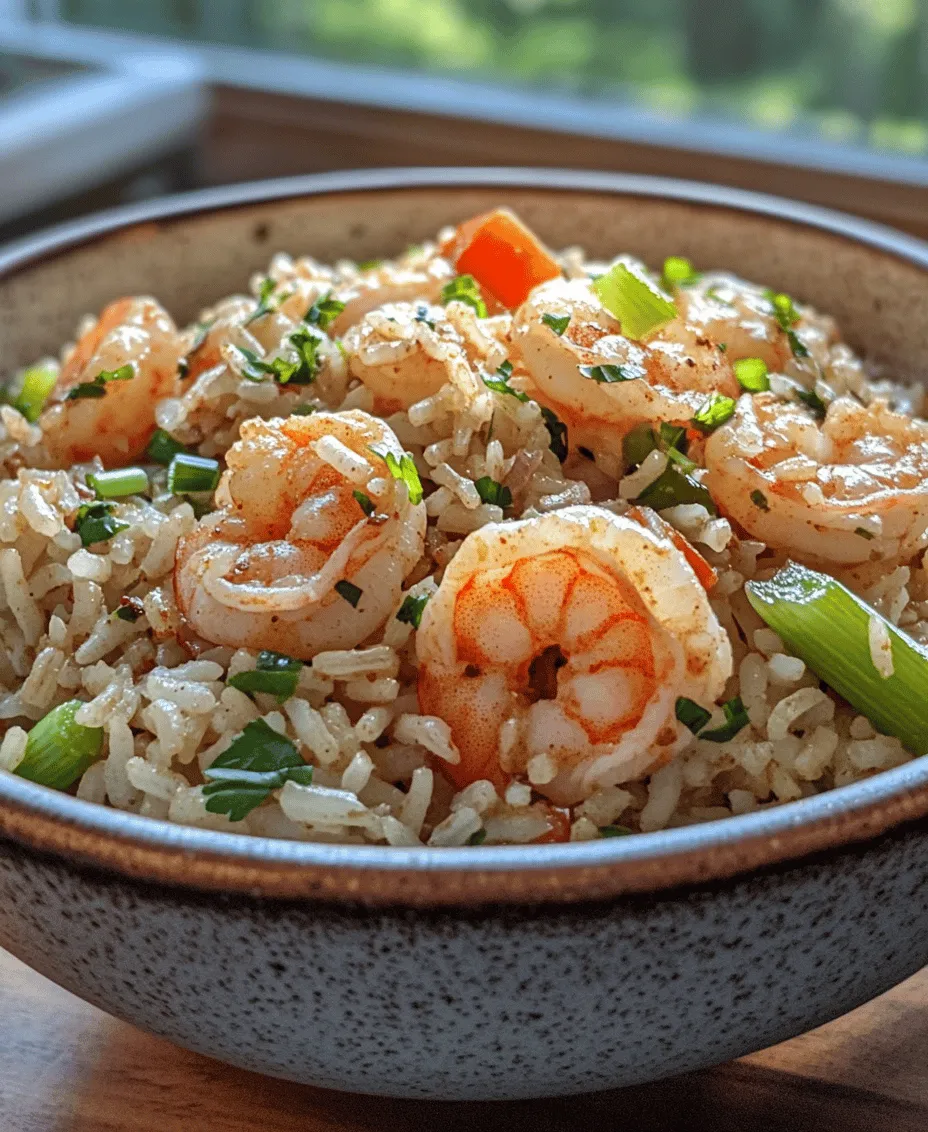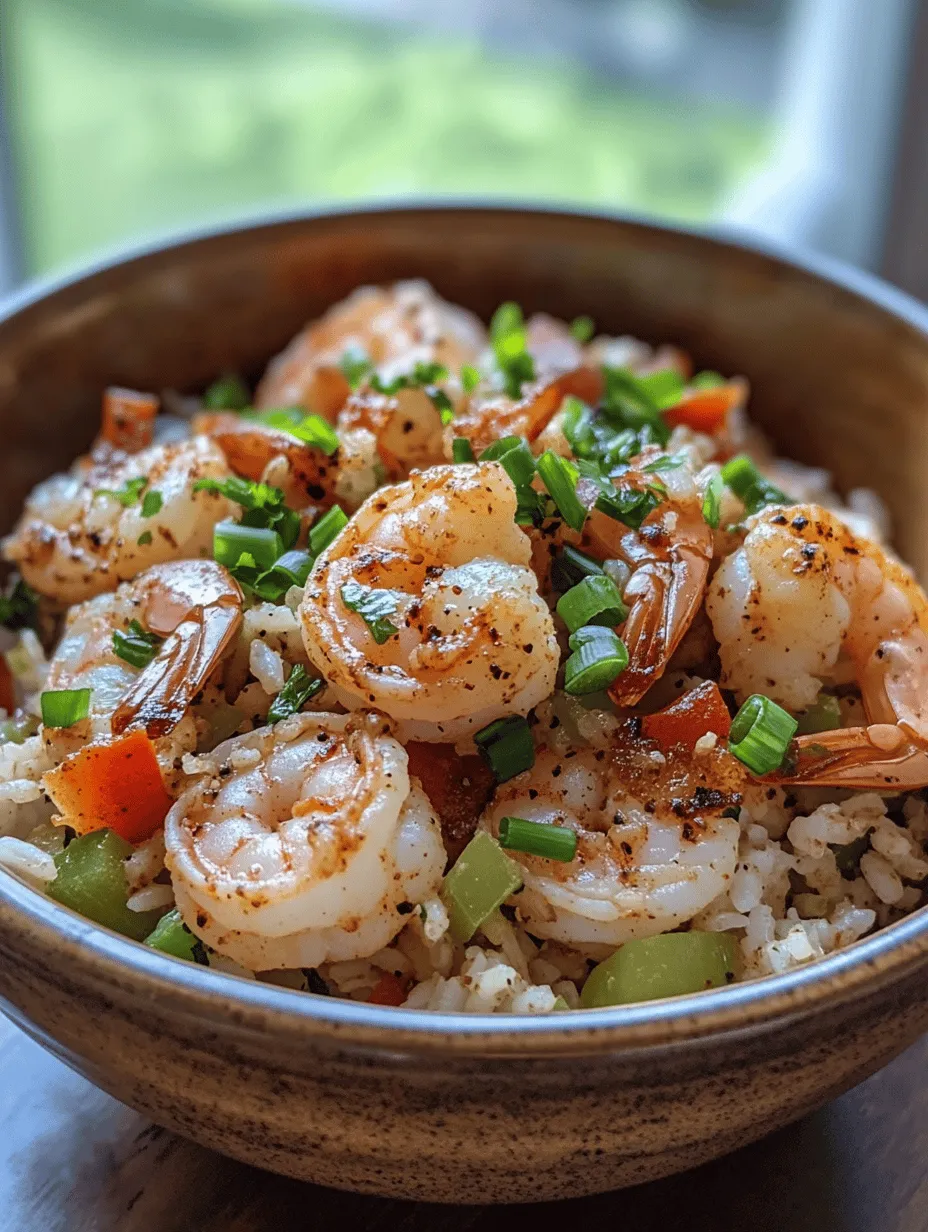Introduction
If you’re in the mood for a dish that embodies the vibrant flavors and rich culinary heritage of the Southern United States, look no further than Shrimp Dirty Rice. This hearty and satisfying dish combines the succulent taste of shrimp with the comforting texture of rice, creating a symphony of flavors that will delight your palate. Originating from the Creole and Cajun kitchens of Louisiana, Dirty Rice is a staple that showcases the ability to transform simple ingredients into something truly extraordinary.
This article will take you on a flavorful journey through the origins of Shrimp Dirty Rice, what makes it a beloved dish, and guide you through the steps to create your very own version. We will discuss essential cooking techniques, highlight the key ingredients that contribute to its unique flavor profile, and provide tips to ensure that your shrimp dirty rice comes out perfectly every time.
Understanding Shrimp Dirty Rice
Dirty Rice has deep roots in Southern cuisine, particularly within the Louisiana Creole tradition. The term “dirty” refers to the dish’s appearance, which comes from the incorporation of ground meats and spices that give the rice a distinct color and flavor. Traditionally, it was made using leftover meats, particularly chicken livers, which were combined with rice and spices to create a hearty meal that was both economical and delicious. Over time, variations emerged, with shrimp becoming a popular protein choice, adding a sweetness and depth of flavor to the dish.
In Louisiana, where the culinary landscape is a blend of French, Spanish, and African influences, Dirty Rice embodies this fusion. Each family may have their own version, with some opting for different meats or seasonings based on personal preference or regional availability. Shrimp, being readily available along the Gulf Coast, brings a fresh, briny taste that complements the rice and the aromatic vegetables beautifully, making it a standout choice.
As we delve deeper into the preparation of Shrimp Dirty Rice, you will discover the importance of each ingredient and the techniques that will elevate your dish from ordinary to extraordinary.
Ingredients Overview
Creating a memorable Shrimp Dirty Rice requires a careful selection of ingredients, each playing a crucial role in building flavors and textures. Here’s a breakdown of the key components:
Shrimp
The star of our dish, shrimp, is essential for adding a burst of flavor and a tender texture. When choosing shrimp, opt for fresh, high-quality options. Look for shrimp that are firm to the touch and have a mild, ocean-like scent. If you purchase shrimp with their shells intact, ensure you peel and devein them before cooking. This not only makes them more enjoyable to eat but also allows the flavors of the dish to penetrate the shrimp, enhancing their taste and tenderness.
Long-Grain White Rice
For this recipe, long-grain white rice is the preferred choice due to its texture and cooking properties. Long-grain rice tends to remain separate and fluffy after cooking, making it ideal for absorbing the flavors of the shrimp and spices. The grains of rice will soak up the aromatic broth created during cooking, ensuring that each bite is flavorful without becoming mushy.
Vegetables
A flavorful base is critical for any good dish, and in Shrimp Dirty Rice, we rely on a combination of aromatic vegetables. The classic “Holy Trinity” of Cajun cooking—onion, green bell pepper, and celery—forms the backbone of our flavor profile. Additionally, garlic adds depth and aromatic richness. These vegetables not only contribute to the dish’s overall taste but also provide essential nutrients and texture that complement the rice and shrimp.
Cajun Seasoning
No Shrimp Dirty Rice would be complete without the warm, robust flavors of Cajun seasoning. This blend typically includes spices such as paprika, cayenne pepper, garlic powder, onion powder, and dried herbs like thyme and oregano. The seasoning not only enhances the dish but also brings out the natural sweetness of the shrimp, creating a well-rounded flavor experience. You can either purchase a pre-made Cajun seasoning or create your own blend to suit your taste preferences.
Optional Ingredients
While the core ingredients are essential, there are options to enhance the dish further. Adding diced bacon can introduce a delightful smokiness and richness, elevating the overall flavor profile. If you prefer a lighter version, you can skip the bacon or substitute it with turkey bacon or omit it altogether. Additionally, you could experiment with other proteins such as sausage or chicken, depending on your cravings and dietary preferences.
Preparation Steps
Once you have gathered your ingredients, it’s time to delve into the preparation process. Each step is designed to build layers of flavor and ensure that your Shrimp Dirty Rice turns out perfectly every time.
Marinating the Shrimp
Before you begin cooking, marinating the shrimp is a crucial step that not only adds flavor but also helps to tenderize the meat. Start by placing your peeled and deveined shrimp in a bowl and seasoning them with a sprinkle of salt, pepper, and a tablespoon of Cajun seasoning. For an added depth of flavor, consider incorporating a splash of hot sauce or a squeeze of lemon juice.
Let the shrimp marinate for at least 15-30 minutes. This short resting period allows the shrimp to absorb the spices and enhances their natural sweetness. If you have time, marinating them for a few hours in the refrigerator will yield even better results, as the flavors have more time to permeate the shrimp.
As you prepare your shrimp, take this time to chop your vegetables and measure out your rice and additional ingredients. Preparation is key in cooking, especially in a dish like Shrimp Dirty Rice, where timing and layering of flavors are essential to achieving the best results.
—
With this foundational understanding of Shrimp Dirty Rice, we are well on our way to crafting a dish that showcases the vibrant flavors of Southern cooking. Stay tuned as we explore the cooking techniques and provide step-by-step instructions to guide you through the entire process, ensuring that your Shrimp Dirty Rice is a culinary triumph.

Cooking the Bacon
To kick off your Shrimp Dirty Rice, start by cooking the bacon to crispy perfection. Begin by selecting high-quality bacon for the best flavor. Place the bacon strips in a large skillet over medium heat. As the bacon cooks, keep an eye on it, turning the strips occasionally to ensure they cook evenly. You want to achieve a deep golden brown color and a crispy texture that will add a delightful crunch to your dish.
Once the bacon reaches the desired crispiness, remove it from the skillet and set it aside on a plate lined with paper towels to absorb excess grease. This step is crucial as it allows the bacon to cool and become even crisper. Don’t discard the bacon drippings! They are packed with flavor and will serve as a base for sautéing your vegetables, enhancing the overall taste of your Shrimp Dirty Rice.
Sautéing the Vegetables
With the bacon drippings still in the skillet, it’s time to sauté the vegetables. Start by adding chopped onions, bell peppers, and celery – known as the “holy trinity” of Southern cooking. These ingredients provide a robust flavor foundation for your dish. Sauté them over medium heat, stirring occasionally, until the onions become translucent and the peppers soften, which should take about 5-7 minutes.
One crucial tip is not to rush this step; the goal is to achieve a balance of textures and flavors. The vegetables should be tender but still retain a slight crunch. To enhance their flavor further, season them with a pinch of salt and pepper while sautéing. This initial seasoning will help draw out the moisture and flavors from the vegetables, setting the stage for the rest of the dish.
Toasting the Rice
Once your vegetables are sautéed to perfection, it’s time to toast the rice. This step may seem unnecessary, but toasting rice before adding liquid significantly enhances the dish’s flavor profile. Add your uncooked rice directly into the skillet with the sautéed vegetables. Stir continuously for about 2-3 minutes, allowing the rice to absorb the flavors from the bacon drippings and vegetables.
Toasting the rice helps create a nutty aroma and a slightly firmer texture, preventing it from becoming mushy during cooking. This will result in a more pleasurable eating experience and a well-rounded flavor in your Shrimp Dirty Rice.
Cooking Instructions
Now that your ingredients are prepared, it’s time to dive into the cooking process. Follow these detailed steps to create your Shrimp Dirty Rice:
1. Prepare the Ingredients: Gather all your ingredients, including cooked bacon, sautéed vegetables, toasted rice, chicken broth, and shrimp.
2. Combine Ingredients: In the same skillet, add the cooked bacon, and pour in the chicken broth. Stir well to combine all the elements, ensuring the rice is evenly coated with the flavorful mixture. This layering of flavors is essential for a rich and satisfying dish.
3. Bring to a Boil: Increase the heat to high until the mixture reaches a rolling boil. Once boiling, reduce the heat to low to allow the dish to simmer.
4. Simmer Without Stirring: Cover the skillet with a tight-fitting lid and let it simmer for about 20 minutes. Avoid stirring during this time, as stirring can release starches from the rice, making it gummy. Instead, let the rice cook undisturbed, allowing it to absorb the broth and flavors.
5. Add the Shrimp: After the 20 minutes have passed, carefully lift the lid and add the shrimp to the skillet. Gently fold them into the rice mixture. The shrimp will cook quickly, so you only need to cover and simmer for an additional 5-7 minutes, or until the shrimp turn pink and opaque. Be cautious not to overcook the shrimp, as they can become rubbery if left too long.
6. Final Touches: Once the shrimp are cooked, remove the skillet from heat and let it sit, covered, for another 5 minutes. This resting period allows the flavors to meld together beautifully.
Garnishing and Serving Suggestions
Presentation is key when serving Shrimp Dirty Rice, as it is not only a feast for the taste buds but also for the eyes. To garnish the dish, finely chop some green onions and fresh parsley. Sprinkle these over the top just before serving to add a pop of color and freshness.
For serving suggestions, consider pairing Shrimp Dirty Rice with a crisp green salad dressed in a light vinaigrette to balance the richness of the dish. Additionally, a side of cornbread can complement the Southern flavors beautifully. If you enjoy beverages with your meal, a chilled glass of white wine or a refreshing iced tea would pair wonderfully with the spiced shrimp and hearty rice.
Nutritional Information
Shrimp Dirty Rice is not only delicious but also packs a nutritional punch. Each serving contains approximately:
– Calories: 400-450, depending on portion size and specific ingredients used.
– Protein: About 25-30 grams, primarily from the shrimp and bacon.
– Fiber: Approximately 3-4 grams, thanks to the vegetables.
– Essential Nutrients: The dish is rich in vitamins A and C from the bell peppers and onions, along with a good source of potassium and iron.
The combination of shrimp and vegetables offers health benefits, including high protein content, essential fatty acids from shrimp, and a variety of vitamins and minerals from the vegetables. This makes Shrimp Dirty Rice a satisfying choice for a balanced meal.
Conclusion
Cooking and enjoying Shrimp Dirty Rice is a delightful experience that encapsulates the comfort and richness of Southern cuisine. The process of combining flavors—from the crispy bacon to the toasty rice and perfectly cooked shrimp—creates a dish that is not only hearty but also deeply satisfying. Whether you’re serving it at a family gathering or enjoying it as a weeknight dinner, this recipe promises to impress with its bold flavors and enticing aromas.
We encourage you to try this Shrimp Dirty Rice recipe and savor the unique blend of flavors that it offers. With each bite, you’ll find yourself transported to a Southern kitchen, celebrating the vibrant culinary traditions that make this dish a timeless favorite. Enjoy your cooking adventure, and don’t forget to share your experience with friends and family!

